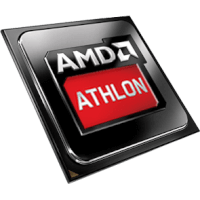

| Intel Pentium 7505 | AMD Athlon Gold 3150U | |
| 2.00 GHz | Frequency | 2.40 GHz |
| 3.50 GHz | Turbo (1 Core) | 3.30 GHz |
| 3.50 GHz | Turbo (All Cores) | 2.40 GHz |
| 2 | Cores | 2 |
| Yes | Hyperthreading ? | Yes |
| No | Overclocking ? | No |
| normal | Core architecture | normal |
| Intel UHD Graphics (Tiger Lake G4) | GPU | AMD Radeon Vega 3 Graphics |
| 12 | DirectX Version | 12 |
| 4 | Max. displays | 3 |
| DDR4-3200 LPDDR4-3733 |
Memory | DDR4-2400 |
| 2 | Memory channels | 2 |
| 64 GB | Max. Memory | 32 GB |
| No | ECC | Yes |
| -- | L2 Cache | 1.00 MB |
| 4.00 MB | L3 Cache | 4.00 MB |
| 4.0 | PCIe version | 3.0 |
| 16 | PCIe lanes | 8 |
| 10 nm | Technology | 14 nm |
| BGA 1526 | Socket | FP5 |
| 15 W | TDP | 15 W |
| VT-x, VT-x EPT, VT-d | Virtualization | AMD-V, SVM |
| Q4/2020 | Release date | Q1/2020 |
| show more detail | show more detail |
Cinebench R23 is the successor of Cinebench R20 and is also based on the Cinema 4 Suite. Cinema 4 is a worldwide used software to create 3D forms. The single-core test only uses one CPU core, the amount of cores or hyperthreading ability doesn't count.
Cinebench R23 is the successor of Cinebench R20 and is also based on the Cinema 4 Suite. Cinema 4 is a worldwide used software to create 3D forms. The multi-core test involves all CPU cores and taks a big advantage of hyperthreading.
Cinebench R20 is the successor of Cinebench R15 and is also based on the Cinema 4 Suite. Cinema 4 is a worldwide used software to create 3D forms. The single-core test only uses one CPU core, the amount of cores or hyperthreading ability doesn't count.
Cinebench R20 is the successor of Cinebench R15 and is also based on the Cinema 4 Suite. Cinema 4 is a worldwide used software to create 3D forms. The multi-core test involves all CPU cores and taks a big advantage of hyperthreading.
Cinebench R15 is the successor of Cinebench 11.5 and is also based on the Cinema 4 Suite. Cinema 4 is a worldwide used software to create 3D forms. The single-core test only uses one CPU core, the amount of cores or hyperthreading ability doesn't count.
Cinebench R15 is the successor of Cinebench 11.5 and is also based on the Cinema 4 Suite. Cinema 4 is a worldwide used software to create 3D forms. The multi-core test involves all CPU cores and taks a big advantage of hyperthreading.
Geekbench 5 is a cross plattform benchmark that heavily uses the systems memory. A fast memory will push the result a lot. The single-core test only uses one CPU core, the amount of cores or hyperthreading ability doesn't count.
Geekbench 5 is a cross plattform benchmark that heavily uses the systems memory. A fast memory will push the result a lot. The multi-core test involves all CPU cores and taks a big advantage of hyperthreading.
The theoretical computing performance of the internal graphics unit of the processor with simple accuracy (32 bit) in GFLOPS. GFLOPS indicates how many billion floating point operations the iGPU can perform per second.
Cinebench 11.5 is based on the Cinema 4D Suite, a software that is popular to generate forms and other stuff in 3D. The single-core test only uses one CPU core, the amount of cores or hyperthreading ability doesn't count.
Cinebench 11.5 is based on the Cinema 4D Suite, a software that is popular to generate forms and other stuff in 3D. The multi-core test involves all CPU cores and taks a big advantage of hyperthreading.